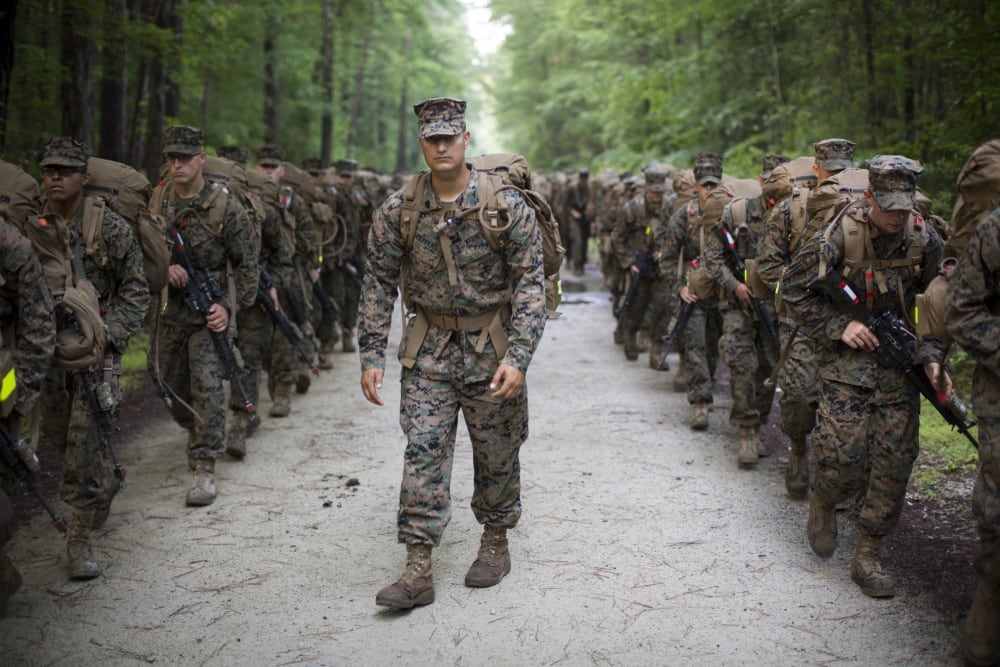The Marine Corps has revealed more about what types of Marines it hopes to add as part of an ambitious plan to fight future wars — but new signs of Washington gridlock may scrap the goal of growing to at least 194,000 active-duty Marines.
Marine Corps Force 2025, a yearlong force structure review, has identified areas where the Corps needs to add Marines, regardless of whether the service gets bigger, said Corps spokesman Maj. Clark Carpenter.
"This may require further growth in areas such as operations in the information environment, indirect fires, anti-armor, counter UAS [unmanned aerial systems] and air defense, anti-ship and sea control capability, increased logistics capacity, and available training and manpower conducive to a 1:3 deployment–to-dwell ratio," Carpenter wrote in an email to Marine Corps Times.
The Marine Corps wants to be able to project power both at sea and ashore despite the proliferation of modern weapons that can destroy ships, amphibious vehicles and aircraft that are hundreds of miles from enemy coasts. Iranian-backed Houthi rebels in Yemen have fired cruise missiles at ships and most recently used an unmanned, remote-controlled boat filled with explosives to attack a Saudi frigate on Jan. 30.
How the Marine Corps grows to meet the challenges of 21st century warfare will be dictated by a number of factors, first and foremost being how much money Congress provides the Corps, Carpenter said.
"The Marine Corps has not established a timeline for that type of growth as it would depend largely on resources available, both people and funding," Carpenter said. "However, if funded, an increase of up to 3,000 Marines per year through both retention and accession shows the best promise to maintain a steady rate of growth while maintaining our high standards and ensuring a balanced force."
Assistant Commandant Gen. Glenn Walters has told Congress that the Marine Corps needs to expand from 182,000 to at least 194,000 active-duty Marines. The fiscal 2017 National Defense Authorization Act calls for adding 3,000 active-duty Marines by October, but Congress has not yet passed a spending bill that would fund the increase.
The Marine Corps is planning to increase accessions by 2,000 additional recruits in the final three months of this fiscal year, a Corps official said. Adding those Marines will not cost much, but growing beyond 185,000 will require more money from Congress, the official said.
President Trump has called for increasing defense spending by $54 billion next year, but the number faced criticism from some Republicans who were hoping to see a bigger surge in spending.
McCain, in a statement, said the figure was, "a mere 3 percent above President Obama’s defense budget, which has left our military underfunded, undersized, and unready to confront threats to our national security ... With a world on fire, America cannot secure peace through strength with just 3 percent more than President Obama’s budget. We can and must do better."
Yet passing a budget with Trump's $54 billion increase would require Congress to lift the budget caps known as sequestration, and Democrats are unlikely to do so without concessions from Republicans on non-defense spending, experts told Marine Corps Times' sister publication Defense News.
Lawmakers have been deadlocked over taxes and spending since an impasse over raising the debt ceiling in 2011 begat the Budget Control Act, which imposed 10 years of budget cuts. To pass Trump’s proposed increase in defense spending, Congress would have to lift the budget caps for fiscal 2018.
Senate Minority Leader Chuck Schumer, D-N.Y., has already said he opposes Trump’s budget plan.
"Republicans need 60 Senate votes to overturn the BCA cap for next year," Benjamin Friedman of the libertarian CATO Institute think tank told Defense News. "I believe Schumer can keep enough of Democrats in line around the idea that an increase in defense must be matched by an increase in non-defense discretionary to stop this."
Trump has embraced the recommendations from a study by the conservative Heritage Foundation think tank, which calls for adding 12 active-duty infantry battalions and one active-duty tank battalion so the Marine Corps can fight two wars at once.
Over the last 20 years, the demand for Marine units to respond to crises and train overseas with allies has increased, said retired Lt. Col. Dakota Wood, the study principal author.
Marines are not getting enough dwell time between deployments and "it’s wearing out the force," said Wood, who served on President Trump’s transition team.
"I think that the Marine Corps, based on signal demand, actually needs to be more than 200,000 — you’re talking 210,000, 220,000," Wood told Marine Corps Times. "That’s a large number of people. How do you train that? How do you get the money to sustain that? Those are decisions that the executive branch and the legislative branch are going to have to debate."









